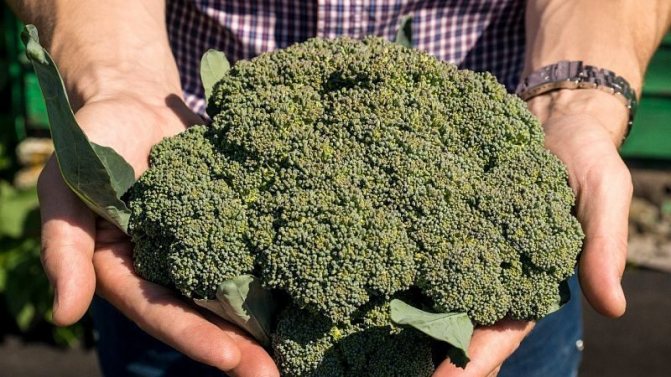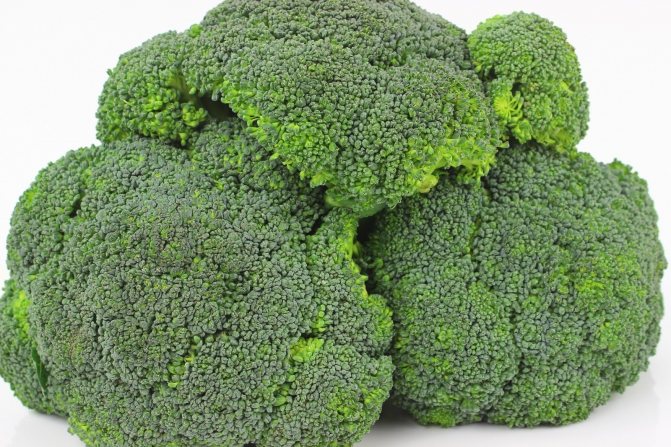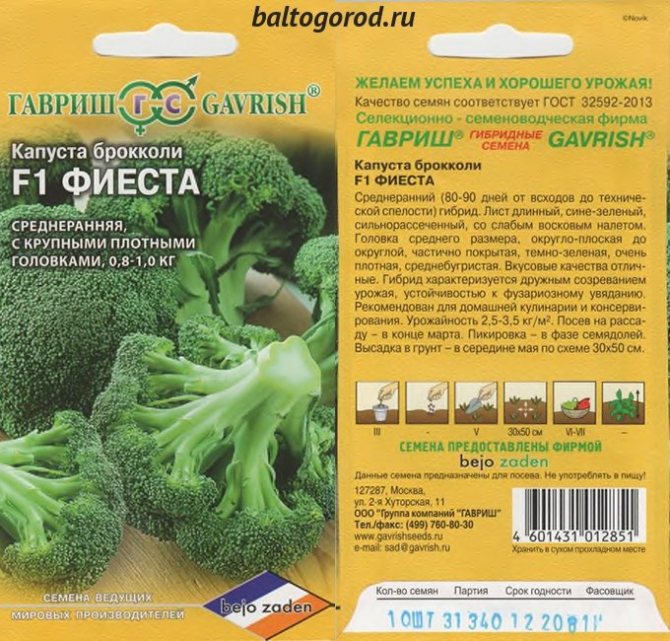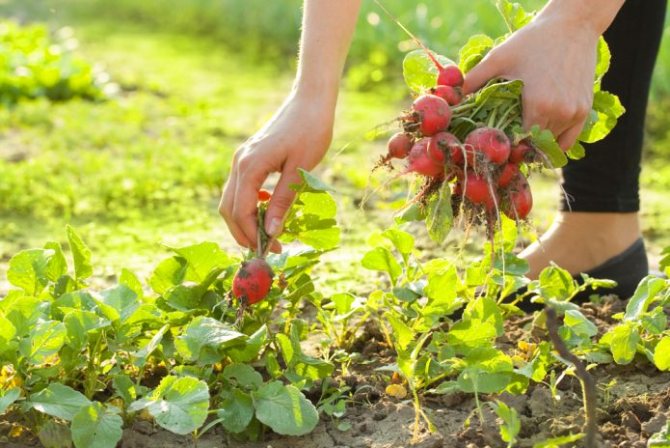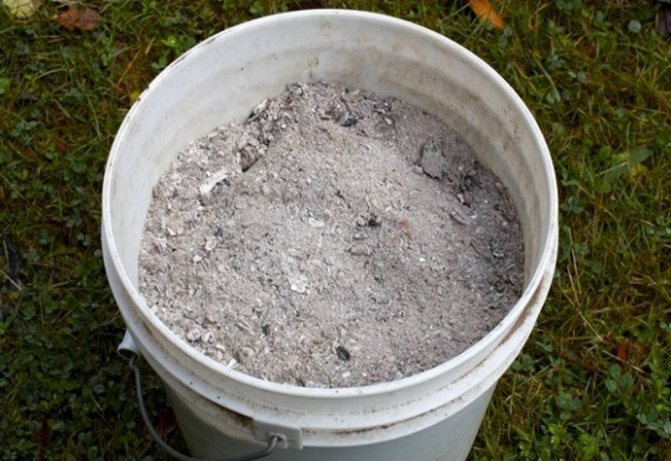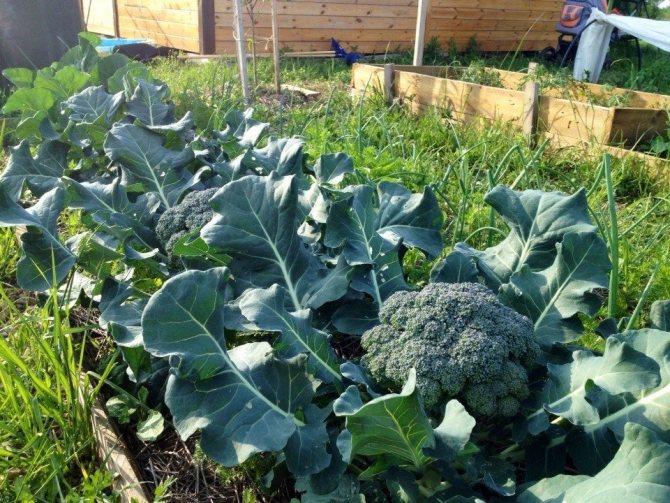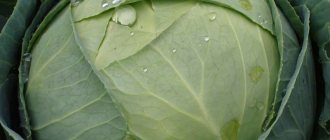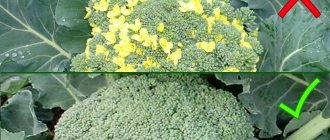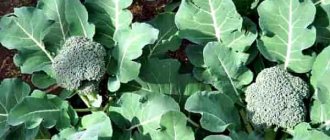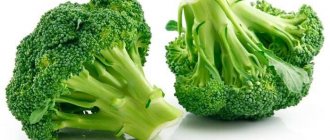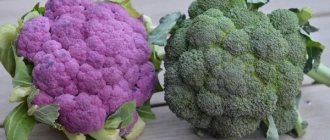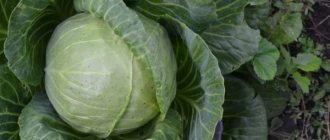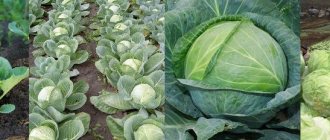Broccoli is still rarely grown in Russian gardens; many people have never even seen it, much less tried it. However, she has a lot of varieties and hybrids of both domestic and foreign selection. One of the best medium-ripening Dutch broccoli hybrids is the F1 Fiesta; there are already many fans of this cabbage in our country.
- 2 Variety description
- 3 Characteristics of broccoli fiesta
- 4 Features of growing broccoli varieties Fiesta
4.1 Video: expert on broccoli varieties Fiesta and Batavia
Features of broccoli cabbage
Broccoli is a close relative of the familiar cauliflower. Among the differences between these two types, the following can be noted:
- Broccoli comes in a wide variety of colors, from dark green to brown and purple.
- It is denser and looser.
- The fleshy stems can be about 20 cm long.
All varieties can be divided into two types of broccoli. Since childhood, we are more familiar with the first species - Calabrian cabbage. It is a thick stem with dense inflorescences. The second type (Italian) has a more delicate taste and consists of a large number of stems with small loose inflorescences. A photo of this broccoli cabbage can be seen below.

As is customary among vegetable crops, broccoli cabbage is divided into varieties and hybrids. It would seem that hybrids have more advantages. They are more fertile, ripen quickly and have a longer shelf life. They are rarely affected by pests and have an excellent appearance. However, there are also disadvantages. This cabbage is not suitable for harvesting seeds, as it is not able to maintain its qualities for the second year. It also loses to taste, although sometimes it may not yield.
Important! You can identify hybrids on the seed packaging by the special designation "F1".
Varieties, unlike hybrids, are excellent for collecting seed, retain their properties well. They have excellent taste. The ripening period is slightly longer than that of hybrids.
All varieties and hybrids can also be conditionally divided into early, late and mid-season. The timing difference between early and late varieties can be very large. Therefore, you should carefully choose the seeds for planting. If the early hybrids are able to ripen in 45-50 days, then the late ones should wait no earlier than in 100-130 days. The ripening period is especially important in cold regions, where summers are short and not very hot.


Also, all varieties of broccoli are divided according to their yield. It all depends on the selected variety and the quality of the seeds. From one square meter, you can collect 1, 5, and even 6-7 kilograms of cabbage. The main thing is to find the right variety for your climatic region and soil condition.
Growing and care
The soil is loosened regularly to improve oxygen availability and cultivation. Water in the first weeks every 3-4 days, and when the cabbage grows up - once a week. On the second day after watering, weeds are weeded.
The first feeding is carried out 2 weeks after transplantation. A solution is prepared from 15 liters of water, 0.5 liters of mullein and 1 tsp. urea. After three weeks, they are fed with a solution of nitrate. During the formation of the heads, they are fertilized with potassium and phosphorus (special complexes for cabbage are suitable).
Early maturing varieties
"Batavia" F1 "
This variety is included in the State Register as a mid-season variety, however, in most regions of Russia it ripens together with early types of broccoli cabbage. The leaves of this cabbage are green with a slight grayish tint. At the edges, they are bubbly and wavy. The head has a rounded shape, rather dense. The inflorescences are easy to separate. The head can weigh up to 1.4 kg, and the side heads are about 250 grams. It takes about two months from planting seedlings in open ground to the ripening of the first inflorescences. The variety can also be grown directly by planting seeds directly into the ground. In this case, disembarkation takes place no earlier than the last week of April. The yield is very good, from 1 m2 you can get up to 2.5 kg of cabbage. Batavia reacts well to hot weather, and is capable of bearing fruit until frost.


Important! After harvesting, it is better to eat the vegetable immediately, since it is stored very little. Used for preservation and freezing.
"Linda"
This is one of the popular hybrids. In a warm area, the ripening period will be approximately 80–90 days, in other regions - about 100–105 days. The fruit is large enough, its weight can be up to 400 grams. Deep green elliptical cabbage. Lateral inflorescences weighing about 55–70 grams each. A bush of medium height. You can collect up to 3 or 4 kg of broccoli on one square meter of the bed. Sowing seeds for seedlings begins in mid-March and ends at the end of April. Seeds are planted in stages every ten days. The variety is rich in vitamins and iodine. They are eaten fresh and canned.
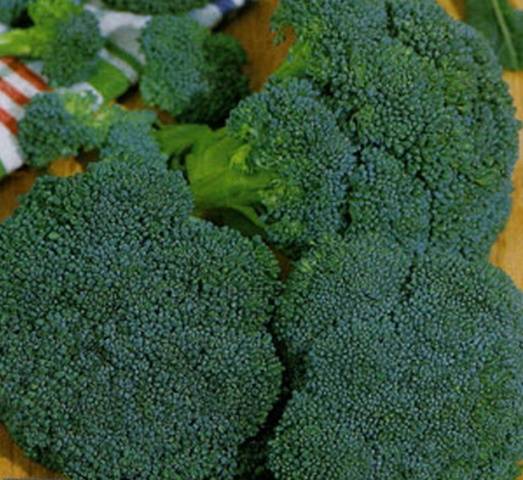

"Lord F1"
Incredibly delicious cabbage. With proper care, high yields can be achieved. Sowing seedlings is carried out from mid-March to mid-April. Broccoli is planted outdoors at the end of April. You can immediately plant seeds in the garden. The leaves are corrugated, dark green in color. The stem is dense and strong. The head is round, slightly flattened, weighing about one and a half kilograms. The inflorescences are easily separated. The maturity of the fetus occurs after 2 months. This is a very good indicator for broccoli. Lateral inflorescences continue to form until late autumn, each weighing about 150-200 grams. About four kilograms of cabbage are harvested from 1 meter. It has a positive effect on the state of blood vessels and the heart.
Attention! Has a high resistance to downy mildew.
"Tone"
"Tonus" broccoli cabbage is one of the most ancient. Each head weighs about 200 grams. The density of inflorescences is average, tends to go into color. The fruit has a brown tint. Lateral inflorescences reach up to 65 grams in weight, the harvest is given in unison. Sowing seeds begins in March. Transplantation into the ground is carried out from May, but at first the plant should be under temporary shelter. Harvesting begins towards the end of June. With the right care, fruiting can be extended until the first frost. Cabbage tastes great and is rich in vitamins and minerals. Suitable for freezing and preservation. Productivity - no more than 2 kg of cabbage from 1 m2.


Possible diseases and pests
Subject to agricultural technology, the hybrid does not get sick. For protection, it is necessary to observe crop rotation: plant cabbage after pumpkin, legumes and nightshade crops and not grow in one place for two years in a row, water moderately, disinfect the soil before sowing.
Of the parasites, caterpillars are the most dangerous, which can destroy the crop at the root. For protection, the cabbage is covered with a non-woven material, and while there are no heads yet, they are treated with insecticides.
Against aphids, spray with infusion of garlic or onions.
Broccoli is a type of cauliflower, but it is considered healthier and tastier. Therefore, the question of growing it on your site becomes relevant for an increasing number of summer residents.Broccoli is not a capricious crop, so even a beginner can take care of it. If you want to grow in your beds broccoli cabbage - varieties and hybrids, reviews and main features are presented to your attention in this article. This information is mainly aimed at helping you not to get confused when choosing.
Mid-season varieties
Ironman f1
This is a hybrid with high yields. It has green leaves with a pronounced blue tint. A head of cabbage of medium size, firm, weighing about 500 grams. The shape of the head is dome-shaped, has a blue-green tint. Side shoots grow well. From the moment the seedlings are planted to the full ripening of the first fruits, it takes about 80 days. Seeds are planted in mid-March, and after 45-50 days they begin to plant in open ground. From one unit of area, you can collect up to 3 kg of fruits.
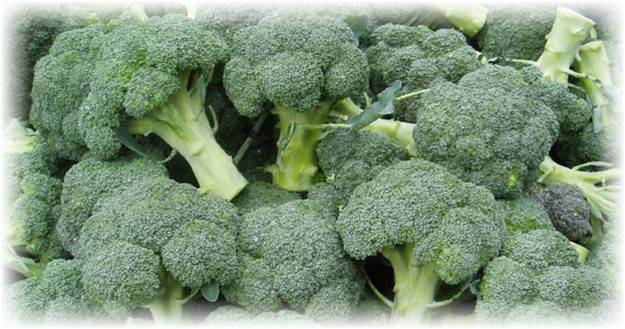

Important! The variety is great for open ground and even in the field.
"Gnome"
Cabbage is distinguished by small gray-green elliptical heads. A head of cabbage can weigh up to 550-600 grams. Inflorescences of medium density and excellent taste. After the main head is cut off, lateral inflorescences grow quickly. They can weigh around 150-200 grams. Like most varieties, seedlings are planted in March, after 35–45 days the seedlings will be completely ready for planting in the garden. The first fruits will ripen within 70 days after planting. From a plot with an area of one square meter, it will be possible to collect from 2 to 4 kg of broccoli. This variety is suitable for fresh storage and conservation.
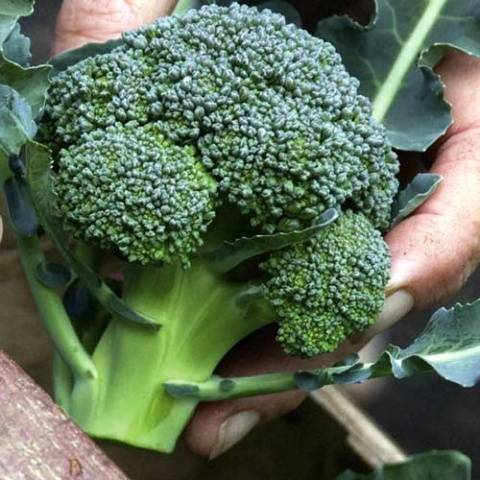

Landing
Seedlings are sown in late March - early April in the middle lane. They are transplanted to a permanent place in late April or early May, when a steady heat comes.
If the seeds were sold in a colored shell, they are not pickled. Untreated grains are pickled in a solution of potassium permanganate 1% for an hour. Then they are rinsed and dried.
Sow in a nutritious loose soil at a shallow depth. With the emergence of seedlings, they are placed in a cool place with a temperature of + 15-17 degrees. Bushes with 4-5 true leaves are planted in the ground according to a 30 by 50 cm pattern.
Late varieties
"Agassi F1"
The variety belongs to hybrid annuals. It is a strong bush with a rounded, slightly flat head. The weight of a head of cabbage can reach up to 700 grams. Landing in a vegetable garden or under shelter is carried out at the end of April. Planting can be carried out in stages with an interval of about 10 days. The fruit ripening process can take 80 days. The yield is high, up to 3.5–4 kg per square meter.
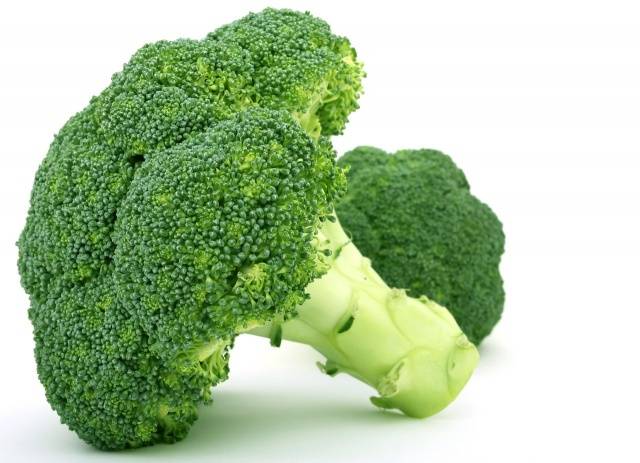

Important! Observing the storage rules, you can enjoy fresh cabbage until the end of winter.
"Marathon F1"
The variety belongs to high-yielding hybrids. The head of cabbage has an elliptical shape and weighs up to 700-800 grams. Head color is blue-green, inflorescences of medium density. Lateral shoots are well developed, grow quickly and in large numbers. Has high resistance to pests, but does not tolerate hot weather. The ripening period lasts about 80 days. Up to 3 kg of excellent cabbage can be harvested from 1 m2. Suitable for eating in any form. It is in high demand among broccoli lovers.
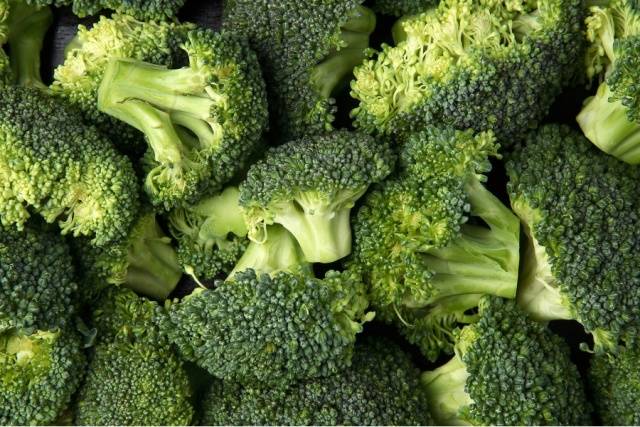

Possible diseases and pests
The most common problem encountered when growing broccoli is caterpillars, which are eaten by the fruit before they are fully ripe. To prevent this problem, it is recommended to use Lutrasil (plant protection covering material).
The culture is resistant to other diseases and pests. In order to avoid the invasion of aphids or flea beetles, it is recommended to process cabbage every 10 days with a weak onion or garlic solution: for 10 liters of water, 2 kg of crushed product.
Testimonials
Broccoli Tonus has collected many different reviews. They say the following about her:
- After cutting off the central part of the cabbage until late autumn gave many additional small "fruits" - Natalia from Moscow.
- The heads are smaller than the stated sizes, but the vegetable is very tasty - Marina from Chelyabinsk.
- The cultivar has a too high leg, it quickly begins to bloom - Maria from St. Petersburg.
- Cabbage is unpretentious, but good watering is needed - Antonina from Ufa.
Broccoli Tonus is beneficial in that it continues to grow new heads after cutting off the central one. With improper care and untimely harvesting, cabbage can disappoint with abundant flowering.
Lucky F1
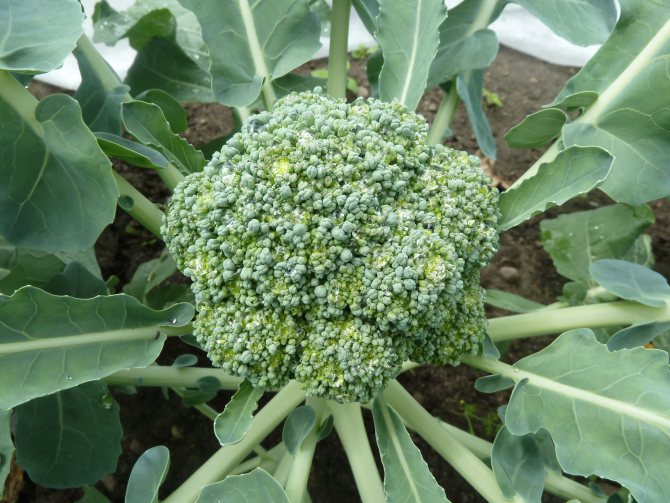

An early ripening hybrid, the period from mass seedlings to reaching the stage of technical ripeness is about 70 days. The heads are dense, rounded, intensely green, weighing from 0.8 to 0.9 kilograms. Lucky F1's bush is large, densely leafy. The advantages of the hybrid include good yield, resistance to powdery mildew and high temperatures. At the same time, he is picky about the level of agricultural technology, especially to seasonal feeding.
Beneficial features
The variety Broccoli Tonus is good for the human body. It is recommended to be included in the diet every day.
- The vegetable has a choleretic effect, prevents bile stagnation and normalizes the digestive process, helps the intestines work properly and has a slight laxative effect.
- Potassium and magnesium help the work of the heart and blood vessels, restore the rhythm and improve the general condition of a person. The vegetable prevents heart attacks and strokes.
- The product is useful for gout, as well as for people who are on a diet.
Cabbage puree Broccoli Tonus is ideal for the first feeding of an infant.

